Playing basketball, tennis, or other court sports puts a ton of stress on your knees. The quick stops, jumps, and sharp changes in direction can pile up and lead to pain or even injury.
A lot of athletes believe they should avoid exercise when their knees hurt. But honestly, that’s not always the best idea.
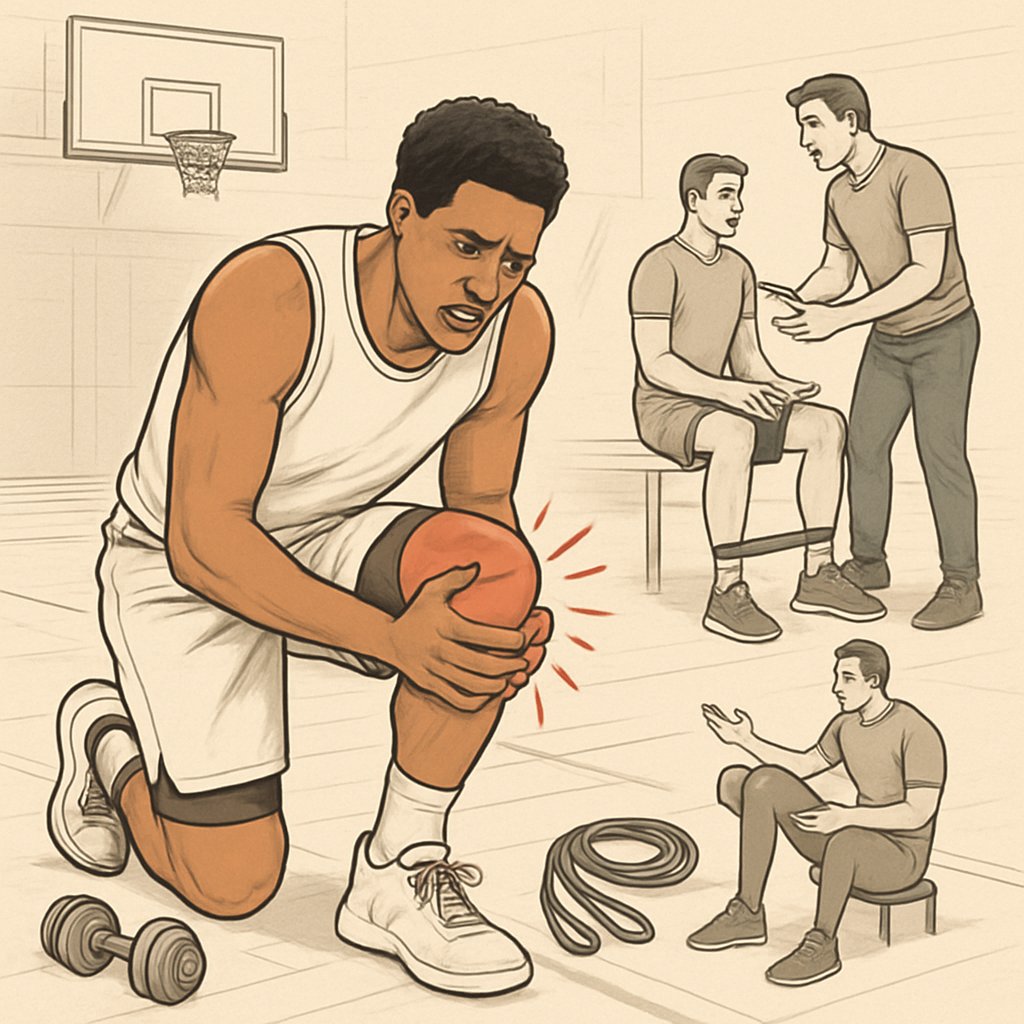
Strength training stands out as one of the best ways to cut down on knee pain and avoid future injuries. Strong muscles around your knee joint give you better support and stability. This takes some pressure off your knees during intense play.
Knee pain basketball players can benefit significantly from tailored strength training routines that emphasize muscle stability and joint protection.
Research actually shows that proper strength training helps your joint cartilage instead of wearing it down.
Understanding the link between athletic performance and knee pain basketball players experience is crucial for effective training.
The real trick is picking the right exercises and doing them safely. You need to build strength in your legs, hips, and core.
When these muscle groups are solid, they work together to protect your knees on the court.
Key Takeaways
- Strength training cuts knee pain by building muscle support
- Strong legs, hips, and core protect knees during court sports
- Knee pain basketball players face can often be mitigated with proper strength training and conditioning.
- Good technique and gradual training help prevent injuries
Understanding Knee Pain on the Court

Basketball players deal with all sorts of knee injuries, from overuse problems to joint wear that creeps up over time. The knee’s complicated structure really makes it vulnerable during all that jumping, pivoting, and stopping, leading to knee pain basketball players often experience. Knee pain basketball players should address through proper training and recovery.
Common Causes of Knee Pain in Athletes
About a quarter of all sports injuries hit the knee. Basketball is rough on your knees with all the jumping and landing.
Patellar tendinitis pops up a lot. That’s when the tendon between your kneecap and shinbone gets inflamed from too much jumping.
Meniscal tears happen when you twist or pivot suddenly. The meniscus cushions the space between your thigh and shin bones.
Ligament injuries come from quick stops or changes in direction. The ACL and MCL take most of the hits during basketball.
Acute injuries can show up out of nowhere—contact or awkward landings can cause instant pain and swelling.
Knee Joint Anatomy and Function
Your knee’s a pretty complex joint. The thighbone, shinbone, and kneecap all move together.
Cartilage covers the bone ends and lets them glide smoothly. The meniscus adds extra cushion and stability.
Four main ligaments keep your knee together:
- ACL – stops forward sliding
- PCL – stops backward sliding
- MCL – keeps the inside stable
- LCL – keeps the outside stable
Muscles around your knee control how it moves and add support. Your quads straighten your leg, and your hamstrings bend it.
Role of Overuse and Joint Stress
Basketball puts repeated stress on your knees, no doubt. Each jump can load your knees with forces three or four times your body weight.
Overuse injuries build up slowly. They sneak in when you don’t give yourself enough time to recover between games or practices.
Landing with straight legs increases knee stress. It’s safer to land with bent knees.
If you play on hard surfaces like concrete, the impact is even worse than on proper courts.
Impact of Arthritis and Osteoarthritis
Osteoarthritis wears down the cartilage in your knee over time. That means bone starts rubbing on bone, which hurts and stiffens things up.
Basketball players might get osteoarthritis earlier than folks who don’t play. All that repeated jumping and pivoting speeds up cartilage wear.
Early signs? Stiffness after sitting, pain during activity, maybe some swelling or warmth in the knee.
Key Muscles Involved in Knee Stability
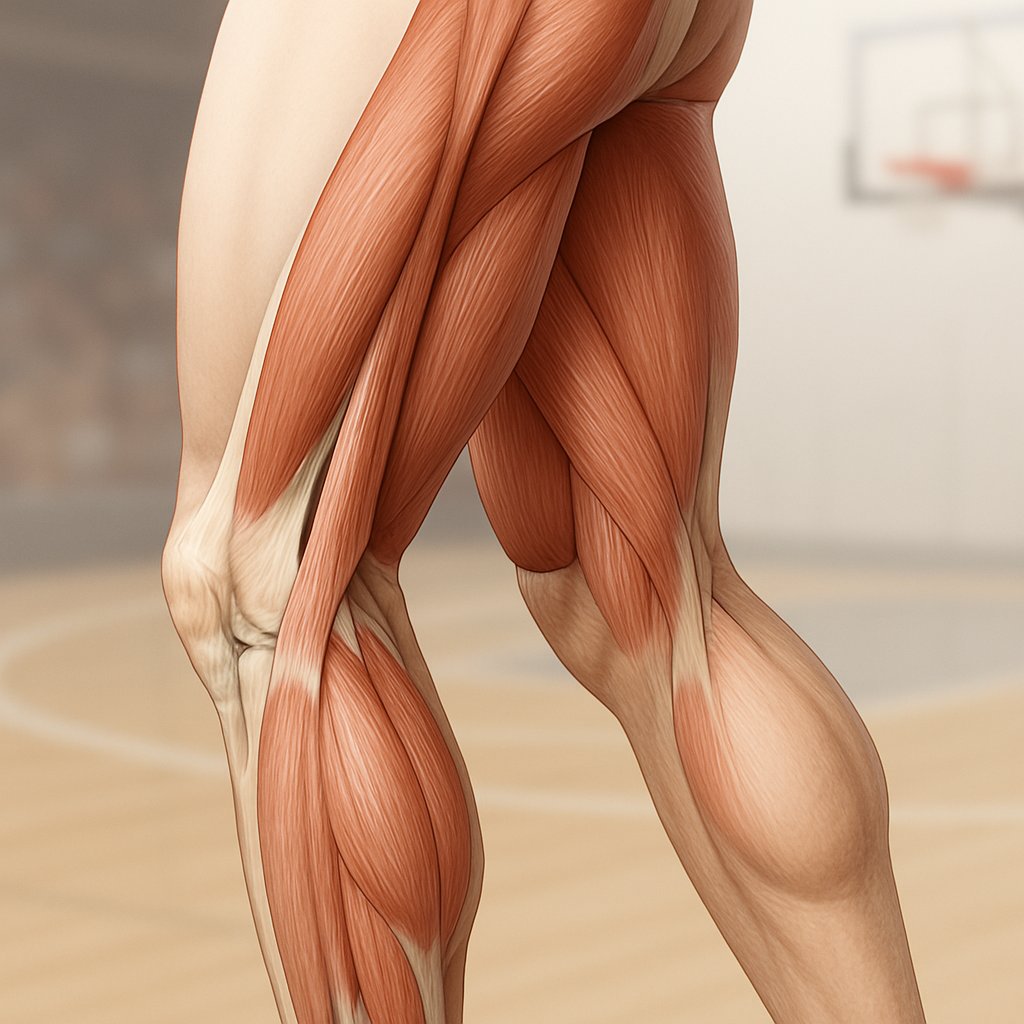
Strong muscles around your knee work as a team to protect the joint during sports. The quadriceps, hamstrings, glutes, and calves all play a role in keeping your knees stable and (hopefully) pain-free.
Quadriceps and Their Importance
Your quadriceps are those big muscles on the front of your thigh. All four parts work together to straighten your knee and absorb shock when you land.
These muscles control how your kneecap moves. If your quads are weak, your kneecap might track poorly and start to ache.
Key quadriceps functions:
- Extend your knee during running and jumping
- Stabilize your kneecap
- Absorb impact when landing
- Support your knee when you cut or pivot
Strong quads mean less stress on your knee joint. They help you handle those quick changes in direction.
Role of Hamstrings and Glutes
Your hamstrings run along the back of your thigh. They bend your knee and work with your quads to control movement.
Weak hamstrings throw off your muscle balance. That puts more strain on your knee ligaments and increases injury risk.
Your glutes control how your hips move and help keep your knees in line. Weak glutes often let your knees cave in during activity.
Important functions:
- Hamstrings: Bend your knee and slow down your leg swing
- Glutes: Keep your knee lined up over your foot
- Together: Give you stability, especially during single-leg moves
Tendons and Supporting Structures
Tendons connect your muscles to the bones around your knee. The patellar tendon ties your kneecap to your shinbone.
Your IT band runs along the outside of your thigh. If it gets tight or irritated, it can cause knee pain.
These structures need to stay flexible and strong. Otherwise, overuse injuries can creep in.
Calves and Ankle Mobility
Your calf muscles affect how your knee moves. Tight calves can mess up your landing and put more stress on your knee.
Good ankle mobility lets you squat and lunge the right way. If your ankles are stiff, your knees end up working harder in ways they shouldn’t.
Ankle mobility helps with:
- Better landing mechanics
- Deeper squats
- Less knee stress when you change direction
Flexible calves and mobile ankles keep your knees lined up when you move on the court.
Principles of Strength Training for Knee Health
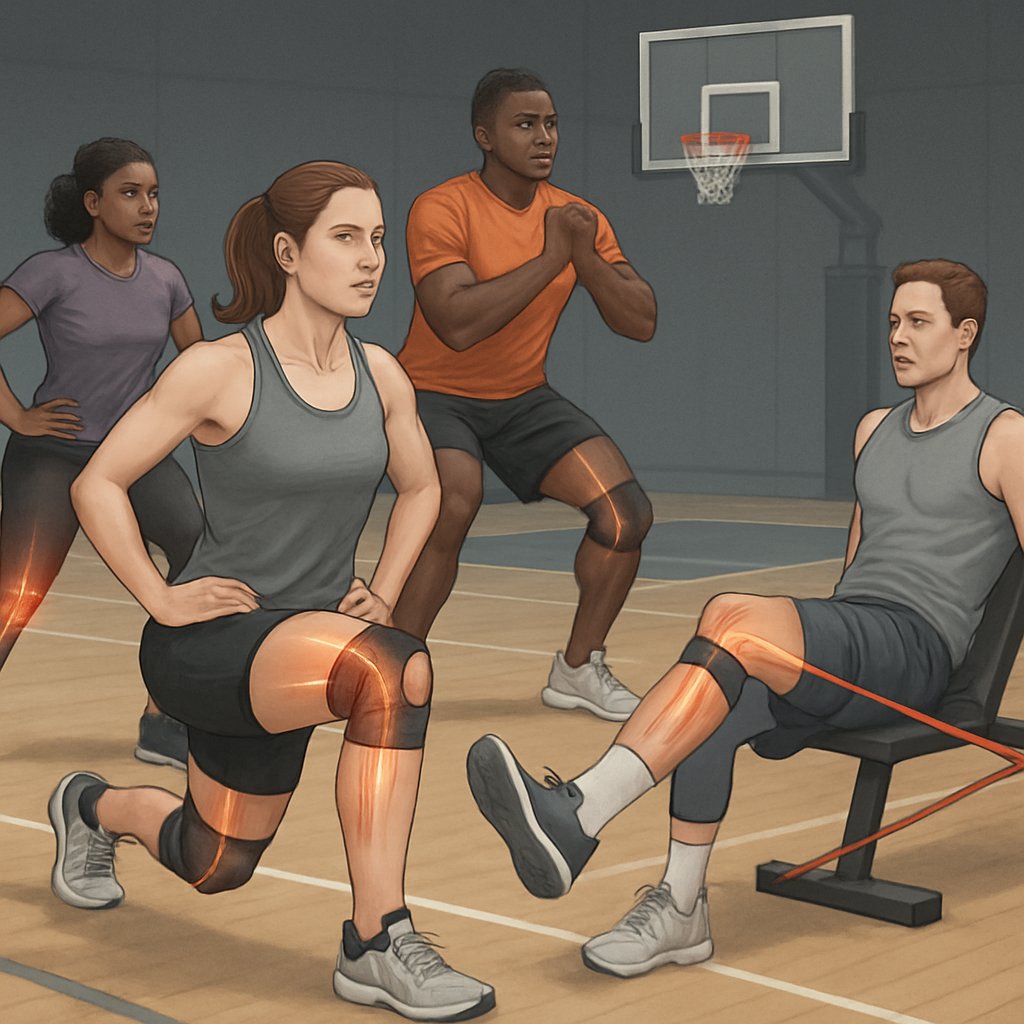
Knee pain basketball players often encounter can be alleviated with consistent strength training and good recovery practices.
Effective strength training for knee health means building muscle support around the joint and learning how to move right. Single-leg work and targeted muscle strengthening lay the groundwork for long-term knee stability.
Focusing on the right exercises can help reduce knee pain basketball players frequently report.
Benefits of Targeted Strength Training
Strength training directly benefits your knees by making the muscles around them stronger. Quads, hamstrings, and glutes that are up to the task take a load off your knee during sports and everyday stuff.
Research shows that strength training actually improves joint cartilage. Controlled loading keeps cartilage healthy and ready for action.
When your muscles work together, your knee gets more stable. Weak muscles force your knee to take on more stress than it should.
Key muscle groups to target:
Many athletes experience knee pain basketball players must address through targeted training.
- Quadriceps (front of thigh)
- Hamstrings (back of thigh)
- Glutes (hip muscles)
- Calves (lower leg)
Stronger muscles also help you move better. Better movement patterns mean less wear and tear on your knees.
Movement Patterns for Knee Protection
Learning proper movement patterns helps your body handle forces the right way. Keep your knee lined up with your hip and ankle.
Key movement patterns:
- Squatting with knees over toes
- Stepping up and down with control
- Landing from jumps with bent knees
Wall sits and step-ups are good ways to practice safely. Start with just your bodyweight before adding anything heavy.
Romanian deadlifts teach you to hinge at the hips instead of bending at the knees. That’s a knee-saver for sure.
Go slow at first and really nail your form. It’s not about how much you lift or how fast you go.
Single-Leg Strengthening Strategies
Single-leg exercises test your knee stability more than two-leg moves. They reveal weaknesses and imbalances you might not notice otherwise.
Begin with single-leg glute bridges to wake up your hips. Move on to single-leg squats as you get stronger.
Progression:
- Single-leg glute bridges
- Single-leg calf raises
- Step-ups
- Single-leg squats
Balance work during single-leg moves boosts your proprioception. That helps your knees react to changes in surface or direction.
Try single-leg exercises two or three times a week. Focus on control and stability—not speed or heavy weight.
Effective Strength Training Solutions on the Court
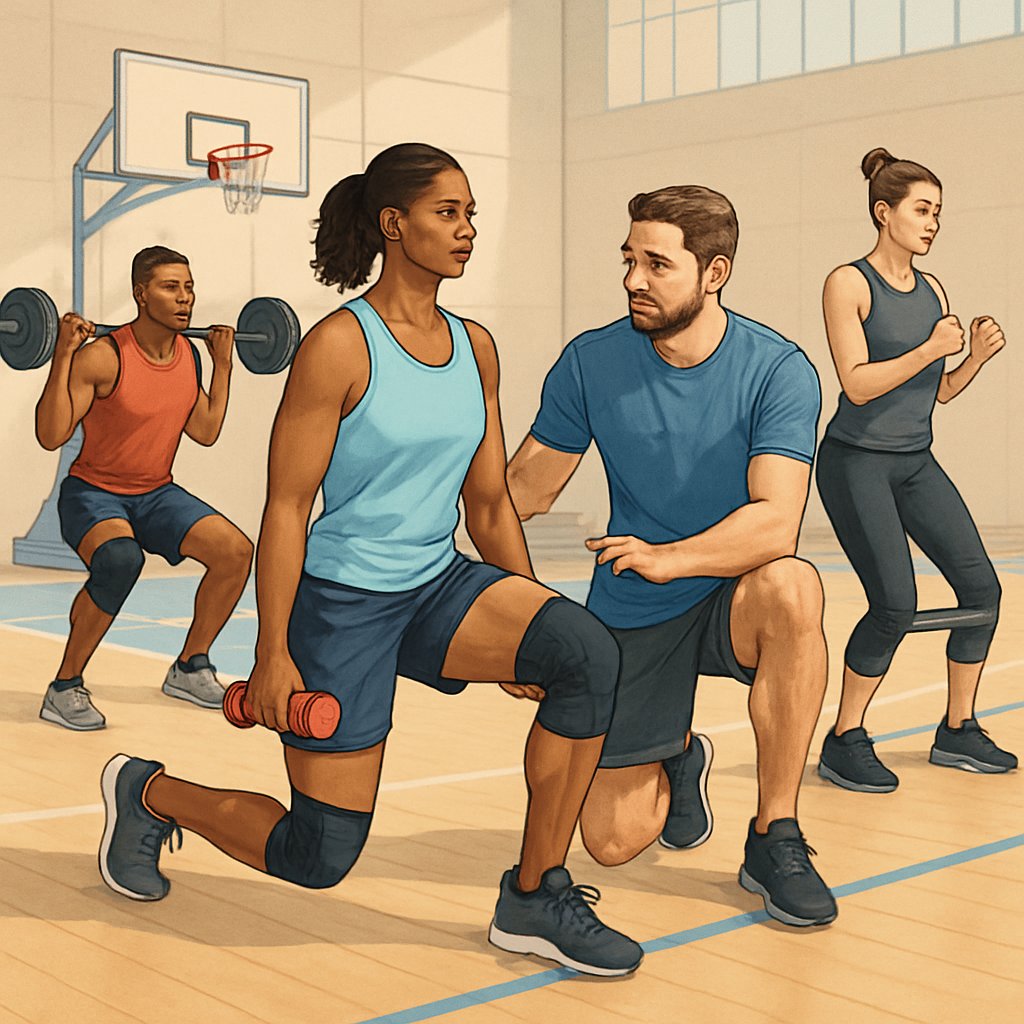
These three core exercises build muscle support around your knees and sharpen the movement patterns that protect your joints. Every movement targets muscle groups that work together to reduce knee stress and boost your game.
Squats for Knee Support
Squats hit your quads, glutes, and hamstrings all at once. These muscles team up to support your knee when you jump or change direction.
Start with bodyweight squats. Stand with your feet shoulder-width apart and toes slightly out.
Lower yourself by pushing your hips back, then bending your knees. Keep your chest up and knees in line with your toes.
Stop when your thighs are about parallel to the floor. Push through your heels to stand up.
Form tips:
- Keep weight on your heels
- Don’t let your knees cave in
- Control how fast you go down
Do 2-3 sets of 12-15 reps. Move on to goblet or barbell squats as you get stronger.
Glute Bridge for Hip and Knee Alignment
Glute bridges fire up your glutes and other muscles that get lazy from sitting. Strong glutes help line up your hips and reduce knee stress.
Lie on your back with bent knees and feet flat. Put your feet about hip-width apart.
Knee pain basketball players endure can often be linked to weaknesses in surrounding muscles.
Squeeze your glutes and push through your heels to lift your hips. Try to make a straight line from knees to shoulders.
Hold at the top for a couple of seconds, then lower slowly. Focus on using your glutes, not your back.
Ways to make it harder:
- Single-leg glute bridge
- Add a resistance band
- Try hip thrusts with weight
Do 2-3 sets of 15-20 reps. This move really helps with hip stability and keeps your knees from caving in when you land.
Deadlift Techniques for Athletes
Deadlifts build the posterior chain strength you need for explosive moves and injury prevention. They also teach you the hip hinge pattern you use in rebounding and defense.
Start with a trap bar or dumbbells—they’re easier for learning form. Stand with feet hip-width apart and the weight close.
Hinge at your hips by pushing them back, keeping your spine neutral. Bend your knees a bit as you reach for the weight.
Drive through your heels and squeeze your glutes to stand back up. Keep the weight close to your legs.
Safety tips:
- Start light and focus on form
- Keep your core tight
- Don’t round your back
Aim for 2-3 sets of 8-12 reps. Deadlifts boost hamstring and glute strength and teach you to move right.
Accessory Exercises and Mobility Work
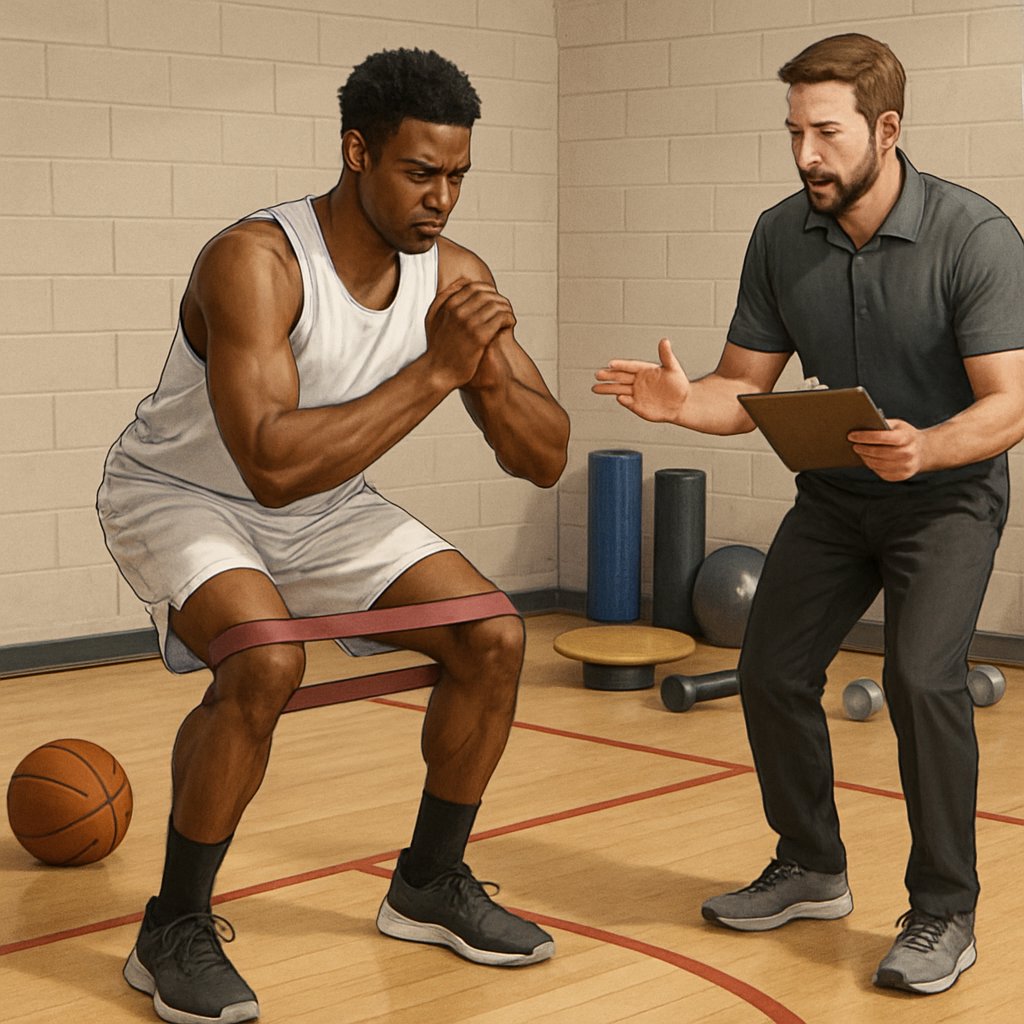
Strong calves and mobile ankles are the unsung heroes of healthy knees. These supporting structures help absorb impact and keep your movement patterns in check.
Calf strength plays a vital role in handling knee pain basketball players often face due to the demands of the game.
Calf Raises for Lower Leg Strength
Calf raises build crucial lower leg strength to help your knees do their job. Strong calves soak up landing forces when you jump or change direction.
Start with bodyweight calf raises. Stand with feet hip-width apart, rise onto your toes, and hold for a couple seconds. Lower slowly.
Once you can do 20 reps easily, move to single-leg calf raises. That’ll help even out strength between your legs.
Add dumbbells or use a calf raise machine for more resistance. Do 3 sets of 12-15 reps, moving slow and steady. Go for full range of motion, not speed.
Try eccentric calf raises for extra benefit. Rise up on both feet, then lower down on one—this strengthens your muscles as they lengthen.
Improving Ankle Mobility
Limited ankle mobility pushes your knees into awkward positions during sports. Over time, this can lead to injuries you really don’t want.
Regular ankle mobility work helps prevent knee overcompensation. It also lowers your risk of getting hurt.
Ankle circles are simple but effective for joint range of motion. Sit or lie down, then rotate each ankle 10 times in both directions.
Move slowly—don’t rush. Try to make your circles smooth and controlled.
Wall ankle stretches focus on the calf muscles that often hold you back. Put your hands on a wall and step one foot back.
Keep your heel down. Lean forward until you feel a gentle stretch.
Calf stretching with a towel is easy to do at home. Sit with your legs out in front and loop a towel around your foot.
Pull gently until you feel the stretch in your calf. This can really help loosen things up.
Stretching for Flexibility
Targeted stretching keeps knee movement healthy. It also cuts down on stiffness, which nobody enjoys.
Consistent flexibility work supports joint health. It can even help your athletic performance.
Hip flexor stretches stop your knees from having to compensate. Tight hip flexors mess with your movement patterns and put more stress on your knees.
Quadriceps stretches are a must for front thigh flexibility. Pull your heel toward your glutes while standing or lying on your side.
Hold each stretch for about 30 seconds. Switch legs and repeat.
Hamstring stretches keep your back thigh muscles from tightening up. Sit and reach for your toes, or use a towel to help while lying down.
Professional Guidance and Prevention

Healthcare professionals can make a huge difference in reducing knee pain. Following proven prevention methods actually protects your joints as you build strength.
Recognizing When to Consult a Physical Therapist
See a physical therapist if knee pain sticks around for more than a few days. If it gets worse during activity, that’s another red flag.
Sharp pain, swelling, or trouble putting weight on your leg? Don’t ignore those signs.
A physical therapist will check for muscle imbalances that might be causing your knee issues. They’ll watch how you move and look for weak spots in your legs and hips.
Key signs you need professional help:
- Pain that won’t go away with rest
- Knee gives out unexpectedly
- Stiffness makes daily activities tough
- Old injuries still bother you
Physical therapists create custom exercise plans for your needs. They teach proper form and make sure you progress safely.
Injury Prevention Strategies
Knowing how to prevent knee pain basketball players experience is key to a long, injury-free career.
Prevention starts with knowing your risk factors. Previous injuries, weak muscles, and bad movement habits all raise your chances of knee trouble.
Essential prevention methods:
- Addressing knee pain basketball players deal with starts with understanding the causes and implementing preventative strategies.
- Knee pain basketball players experience often requires a proactive approach to training and recovery.
- Always warm up before practice or games
- Cool down with gentle stretching
- Strengthen muscles around your knees
- Practice good landing and cutting techniques
Mix strength training with stretching and low-impact exercises. That combo keeps your joints healthier.
Pay extra attention to your quadriceps, hamstrings, and hips. Weak hips, in particular, often lead to knee pain by changing your movement.
Swap out some high-impact drills for strength-building moves that are easier on your knees. Wall-sits, step-ups, and Romanian deadlifts work well.
During your training, remember that knee pain basketball players encounter can often be reduced with proper technique and strength work.
Integrating Strength Training Into Practice
Add knee strengthening exercises to your training schedule. Try for two or three sessions a week on days you don’t have games.
Start each session with a 5-10 minute warm-up. Focus on slow, controlled movements instead of lifting heavy right away.
Sample weekly schedule:
- Monday: Lower body strength
- Wednesday: Core and hip stability
- Friday: Functional movement work
Work with your coach to balance strength and skill training. Too much volume can actually bump up your injury risk.
Track progress using simple things like pain levels or how many reps you can do. That way, you’ll know when to push a little harder.
Make strength training a regular part of your routine, not just something you do when you’re hurt.
Frequently Asked Questions
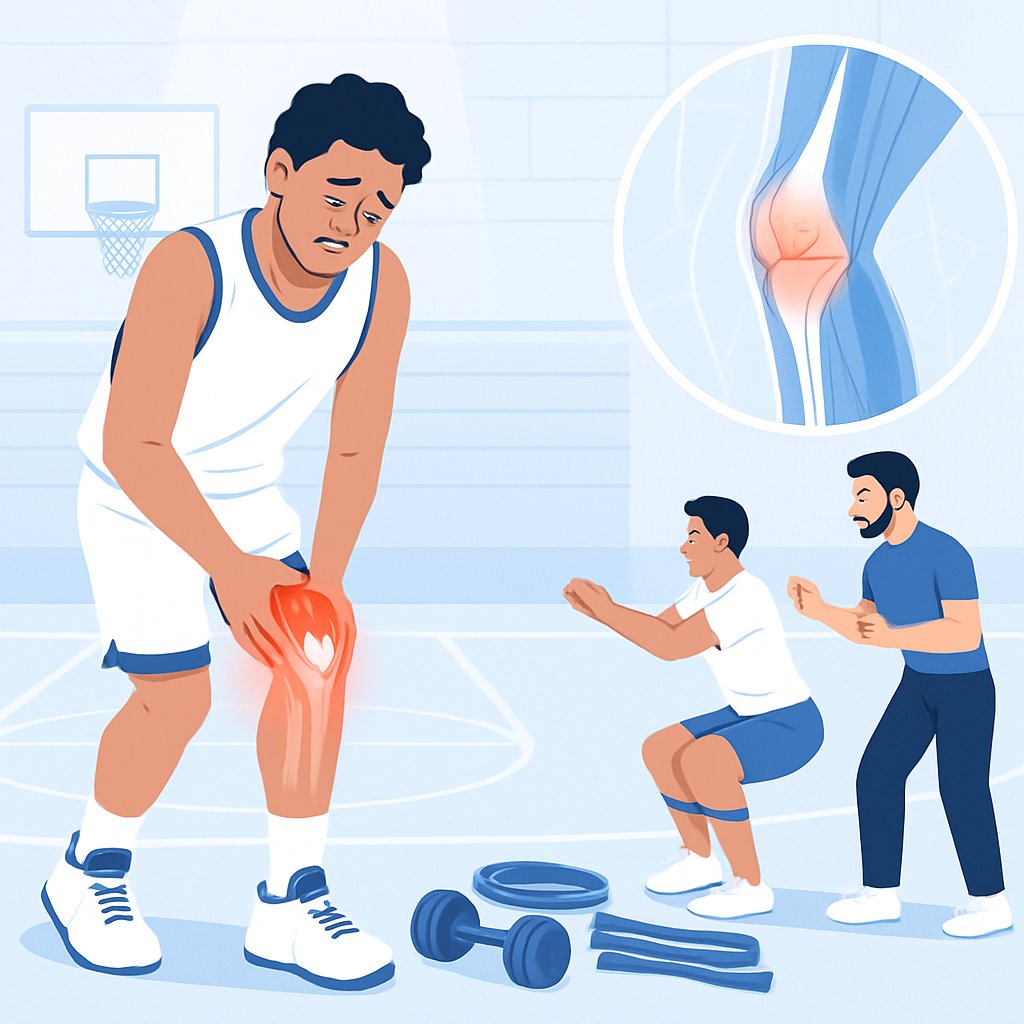
Athletes—especially tennis players—have plenty of questions about managing knee pain with strength training. Here are some practical answers that can help you keep performing at your best.
What exercises can alleviate knee pain for tennis players?
Straight leg raises work your quadriceps without stressing the knee joint. You can do these lying on your back—simple and effective.
Hamstring curls with resistance bands target the back of your thigh. These muscles help keep your knee stable during fast moves.
Calf raises build up your lower legs to help absorb impact. Start with your own bodyweight and add difficulty slowly.
Wall sits are great for building quadriceps strength and keeping your alignment in check. Hold for 15-30 seconds, then try to go longer over time.
What are effective physiotherapy exercises for managing knee pain?
Step-ups on a low platform strengthen your whole leg and improve balance. Start with a 6-8 inch step.
Glute bridges wake up your hip muscles, which are key for knee support. Weak glutes often play a role in knee pain.
Incorporating exercises specifically to deal with knee pain basketball players face can enhance overall performance.
Side-lying leg lifts hit the hip abductors. These muscles help control where your knee goes when you move.
Gentle range of motion exercises, like heel slides, help you stay flexible. Try to do these daily to avoid stiffness.
Which strength training exercises are recommended for athletes with knee discomfort?
Squats—done with good form—work your quads and glutes. Start with just your bodyweight.
Lunges build single-leg strength and stability. Begin with stationary lunges and focus on moving slowly.
Leg presses let you strengthen your legs with back support. This puts less pressure on your knees than free weights.
Are there specific exercises to avoid when experiencing knee pain?
Skip deep squats that push your knees past your toes. That just adds extra pressure on your joints.
Hold off on high-impact jumping exercises until your pain is gone. They can make knee problems worse.
Avoid running on hard surfaces or hills when your knees hurt. Stick to flat, softer ground.
What are the home remedies for reducing knee pain from sports activities?
Implementing strength training routines specifically aimed at knee pain basketball players can lead to improved performance and reduced injury risk.
Apply ice for 15-20 minutes after activity to cut down on swelling. Always wrap the ice pack in a thin towel to protect your skin.
Elevate your leg while you rest to help with inflammation. Try to keep your knee above your heart.
Gentle stretching—calf, hamstring, and quadriceps—can ease muscle tension. Hold each stretch for about 30 seconds.
How can I continue strength training while dealing with knee pain?
Try focusing on upper body exercises that keep your knees out of the equation. Pull-ups, rows, and shoulder presses come to mind as solid choices.
For lower body work, stick to movements where you can sit or lie down. Leg extensions or hamstring curls on machines offer extra support and don’t put much strain on your knees.
Dial back the weight and pay attention to your form. You’ll still see gains with lighter resistance—sometimes less really is more.
Swimming can be a lifesaver here. It gives you a full-body workout, but the water takes the pressure off your knees.
